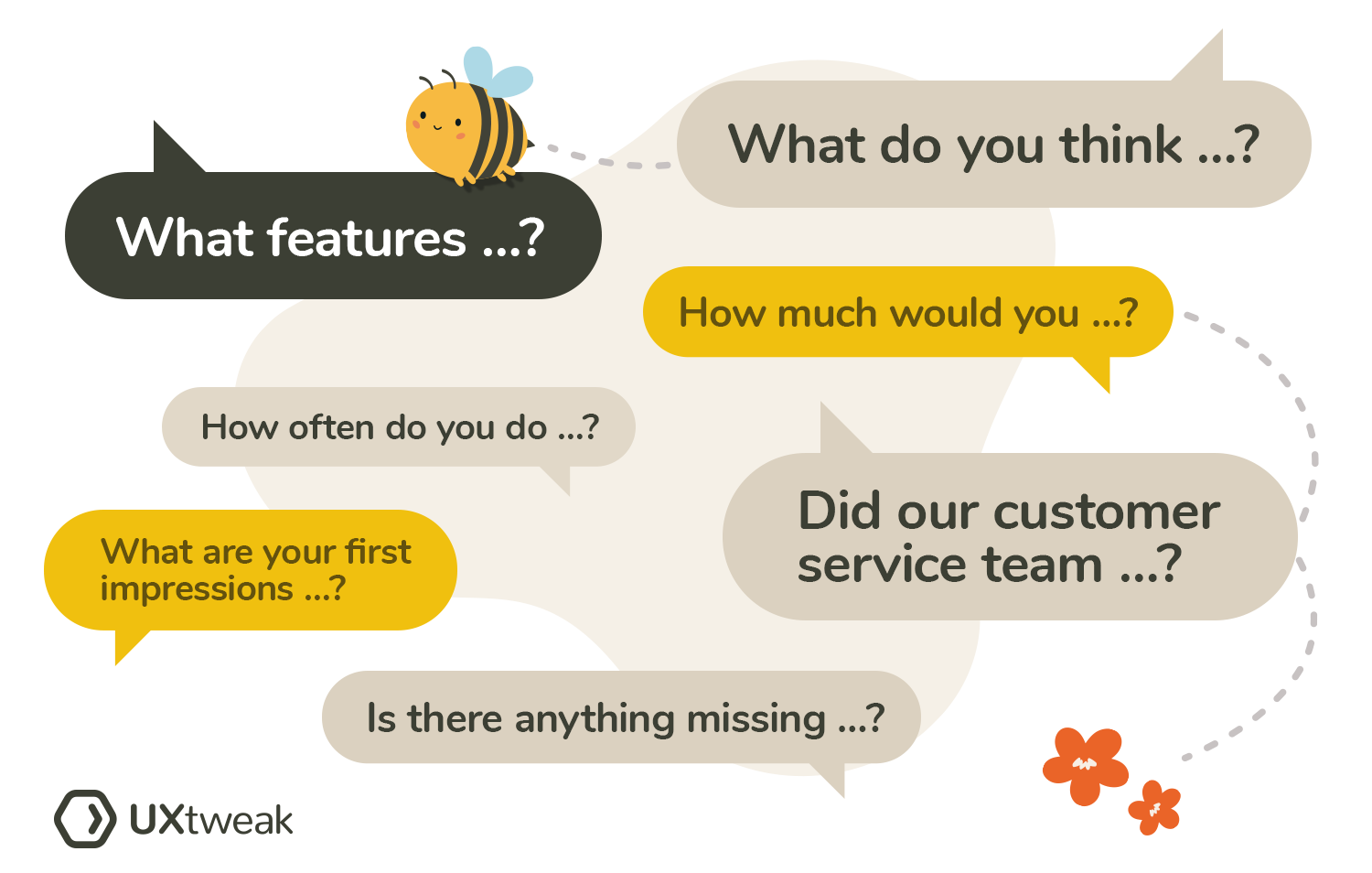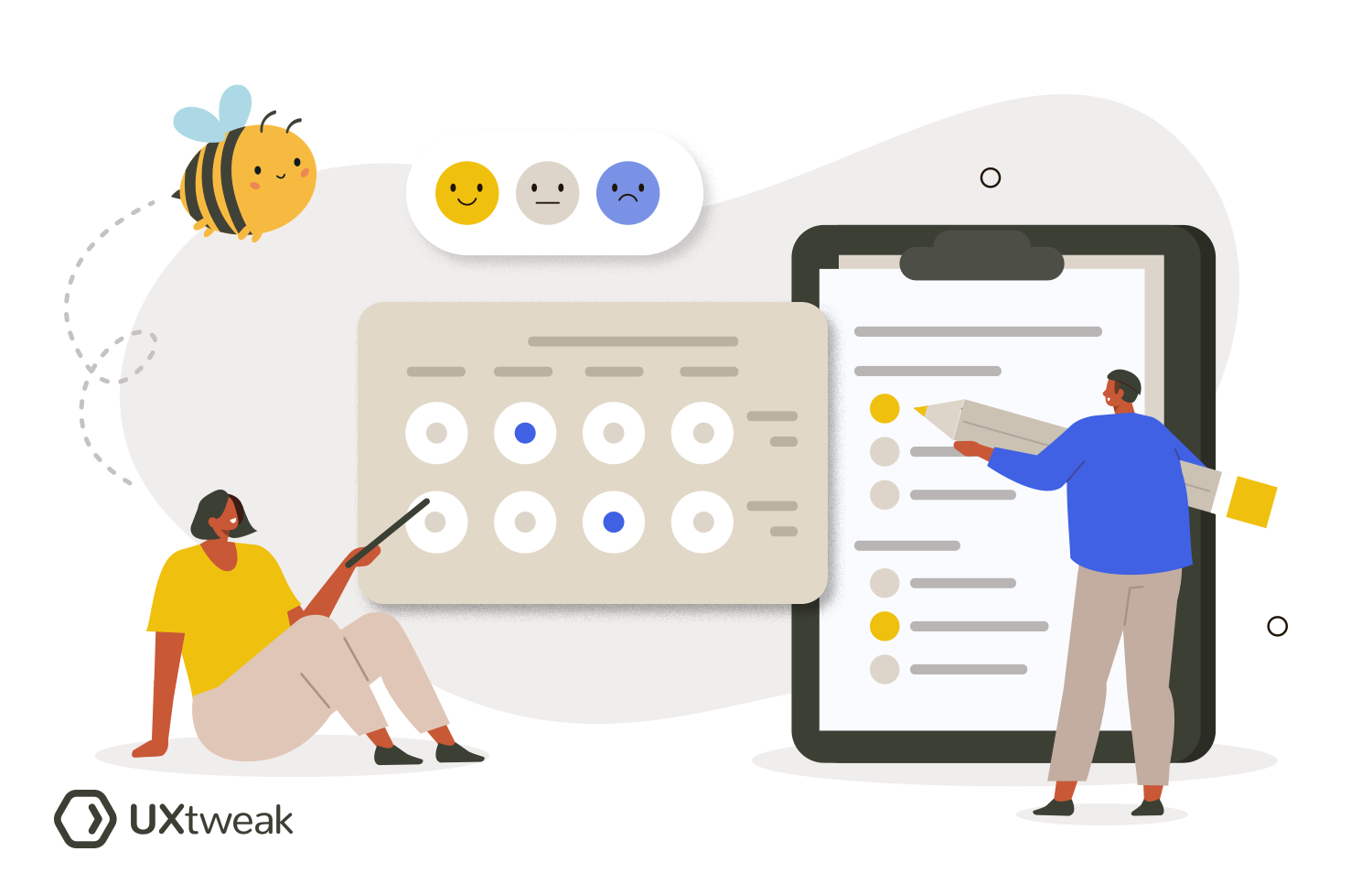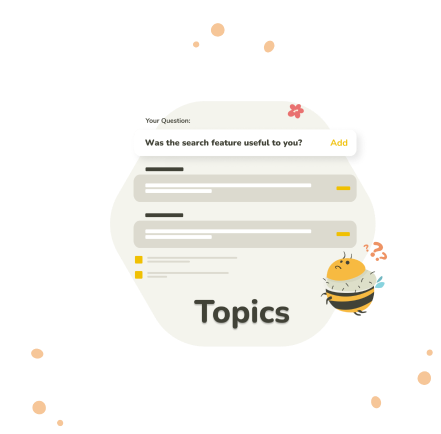Preparing to collect feedback from users always seems like an easy process, until you get to a part where you need to come up with good user feedback questions that correspond to your goals.
The wording and the quality of your questions will directly influence the success of the study, as even a tiny bit of bias can significantly skew the results.
Below, we’ll introduce you to some of the best examples of effective user feedback questions, depending on the goals of your study. You’ll also find our special recommendations for writing your own questions: what to focus on and what to avoid.
User feedback questions to ask in your survey

Below, we’ll describe some of the common categories of user feedback questions that you can use in your survey to understand the users better.
Questions to understand your users
Asking questions from this category can help to get a better understanding of who your users are in general, how they approach certain problems and what you can do to help them with your product.
➡️Example:
- How often do you do …?
- Are there any products that you prefer to use to do …?
- How do you currently approach this problem?
- How much would you pay for such a product?
Questions to understand your users’ needs
These questions help you understand what your users want and expect from your product or service. They help to better understand what problems your product needs to solve and what features will be necessary.
➡️Example:
- How are you currently solving this problem?
- Do you face any struggles when doing …?
- What features do you expect the product to have?
- Is there anything missing in our product/service that you would like to see?
- What improvements would you suggest for our product/service?
Questions to improve your customer service experience
Customer service experience questions are made to help you evaluate the performance of your customer service team. By asking those questions you’ll find out if users’ problems are solved effectively, in a timely manner and pinpoint areas that could be improved.
➡️Example:
- How would you rate the level of customer service provided?
- Did our customer service team respond to your queries in a timely manner?
- Did you face any issues when interacting with our customer service team?
Questions to learn about user preferences
Questing for uncovering users’ preferences are often used in preference tests and can be a great source of user feedback when you’re struggling to choose between two or more design elements, fonts, colors etc.
However, you can also use those questions in user feedback surveys to find out more about users’ general preferences in relation to your product or service.
➡️Example:
- Which version of the homepage evokes more trust in you?
- Which font type and size do you find more comfortable to read?
- Which color scheme do you prefer for this app?
- What are your favorite features of our product/service?
- Are there any features that you don’t use or find unnecessary?
Questions to understand the first impression of your product
First impression questions are often asked in 5 second tests and aim to find out how users feel about your product upon first use, or just a first sight. These can help to understand if people perceive your product the way you want them to, understand your messaging and like the design.
➡️Example:
- What is this page about?
- What do you think is the mission of this company?
- What elements do you recall?
- What is your first impression of the product’s design?
Questions to improve your website or app
These types of questions are usually focused on learning more about the user’s overall experience with your digital product. It includes the intuitiveness of navigation, UI design, functionality etc.
These questions are mostly used in usability tests and can be often formulated as tasks that aim at discovering how users interact with the product and what roadblocks they encounter.
➡️Example:
- What are your first impressions of this website/app?
- What are your biggest doubts or hesitations about this website/app?
- Describe the design of this website/app using only 3 words.
- Try to find information about …
- You’re looking to buy a …. Find the one you like and complete the checkout.
Questions to improve your product or service
These types of questions help to better understand users’ overall impression of the product, learn more details about their experience and generate ideas on how the product could be improved.
➡️Example:
- How would you rate the overall quality of the product/service?
- If the product was available now, would you buy it?
- Will this product/service help you solve your problems?
- What do you like/dislike the most about the product/service?
- Is there anything you’d change about the product/service?
- Is there anything the product is missing?
Question to learn about your competitors
These are all the questions that can help you get a better understanding of the competitors on the market and to what extent your users are familiar with them. Analyzing the answers will help to understand what your competitors are doing better and how you can get ahead of them.
➡️Example:
- Have you used a similar product/service before?
- Is there anything our competitors offer that we don’t?
- Is there anything missing in the product of our competitors?
- How did you solve this problem in the past?
- If you weren’t using us, what do you think you would do instead?
Questions for the end of a user feedback survey
At the end of a user feedback survey we’re usually asking questions that help us make sure nothing was left out. Often this is also a great place to ask participant’s overall impression of the survey itself and encourage them to share final thoughts or unspoken opinions.
➡️Example:
- Is there anything you would like to add?
- Do you have any final comments or feedback you would like to share?
- Is there anything we missed in the survey that you would like to add?
- Would you be willing to participate in future user feedback surveys?
- Can we reach out with a follow up?
Best practices for writing good user feedback questions

- Know what the goal of your survey is – focusing on the goal of your survey can help to write effective and relevant questions that will get needed insights out of your respondents.
- Encourage honest feedback – this will help to obtain accurate information about users’ experiences and problems. You need negative feedback from them as much as the positive. You want to know what bad they have to say about your product, as that’s exactly the type of feedback that is going to drive future improvement.
- Choose the right format of your question – the format of your question will decide how much information you’ll get from the survey participants and how accurate their answers are going to be. Therefore, choose it wisely. It could be a rating scale like NPS or CSAT surveys, open-ended questions, multiple choice or other types.
- In multiple options user questions add an “other” option – give your participants a so-called “way out” of the question. When none of your suggested answer options are relevant to them, let them choose “other” and elaborate on their opinion in a free text box.
- Test your questions – run a pilot of your survey on a smaller group of respondents. This will help to ensure that your questions’ wording is clear to them, respondents have to problems with answering them and don’t face any confusions.
3 mistakes to avoid when creating a user feedback survey

Let’s take a look at some of the most common mistakes teams make when creating a user feedback survey:
Don’t ask leading questions
Leading questions apply that you’re consciously or unconsciously trying to influence participants’ answer to the question. This usually happens because of the incorrect wording of your questions that pushes participants towards a certain response.
Here’s an example:
- Leading question: How satisfied were you with our customer service?
- Good question: What are your thoughts on our customer service?
Try to avoid asking leading questions as they bring unwanted bias to your survey and, therefore, inaccurate results. Instead, formulate the questions in a neutral way that doesn’t suggest a specific answer.
Don’t go overboard with the number of questions
This point is specifically important, as making your survey too long can lead to survey fatigue, when users become tired, bored, or frustrated with the survey. As a result your survey completion rates might drop and you won’t get enough responses to drive any conclusions.
A rule of thumb for user feedback collection surveys is to make sure they take no longer than 5-10 minutes to complete. This time usually translates to around 10-20 questions which is more than enough in most cases.
Respect the time of your respondents and include only the questions that are relevant to the goal of your study. Don’t forget to let them know survey completion times in advance.
Avoid Yes/No questions
Questions like “Do you like our product? Yes/No” don’t provide much insight into users’ thoughts and opinions.
They are suitable for gathering quick feedback on simple topics, however, they won’t provide you with in-depth insights into why users feel that way and what can be improved.
To gain a comprehensive understanding of your customers experience, their wants, needs and suggestions, try to avoid putting those in your survey. Instead, focus either on more open-ended types of questions, rating scales or just provide more detailed answer options that could reflect customers opinions about a certain topic.
Wrapping up
We hope this guide was helpful and you now have a clear idea of what to ask in your user feedback surveys, how to write unbiased questions and what types of questions to avoid.
To easily gather user feedback try UXtweak Survey Tool! It allows you to create various types of surveys in a matter of minutes, analyzes the results for you and puts them all together in comprehensive PDF reports!
Register for a free UXtweak account and get to know your users better!


